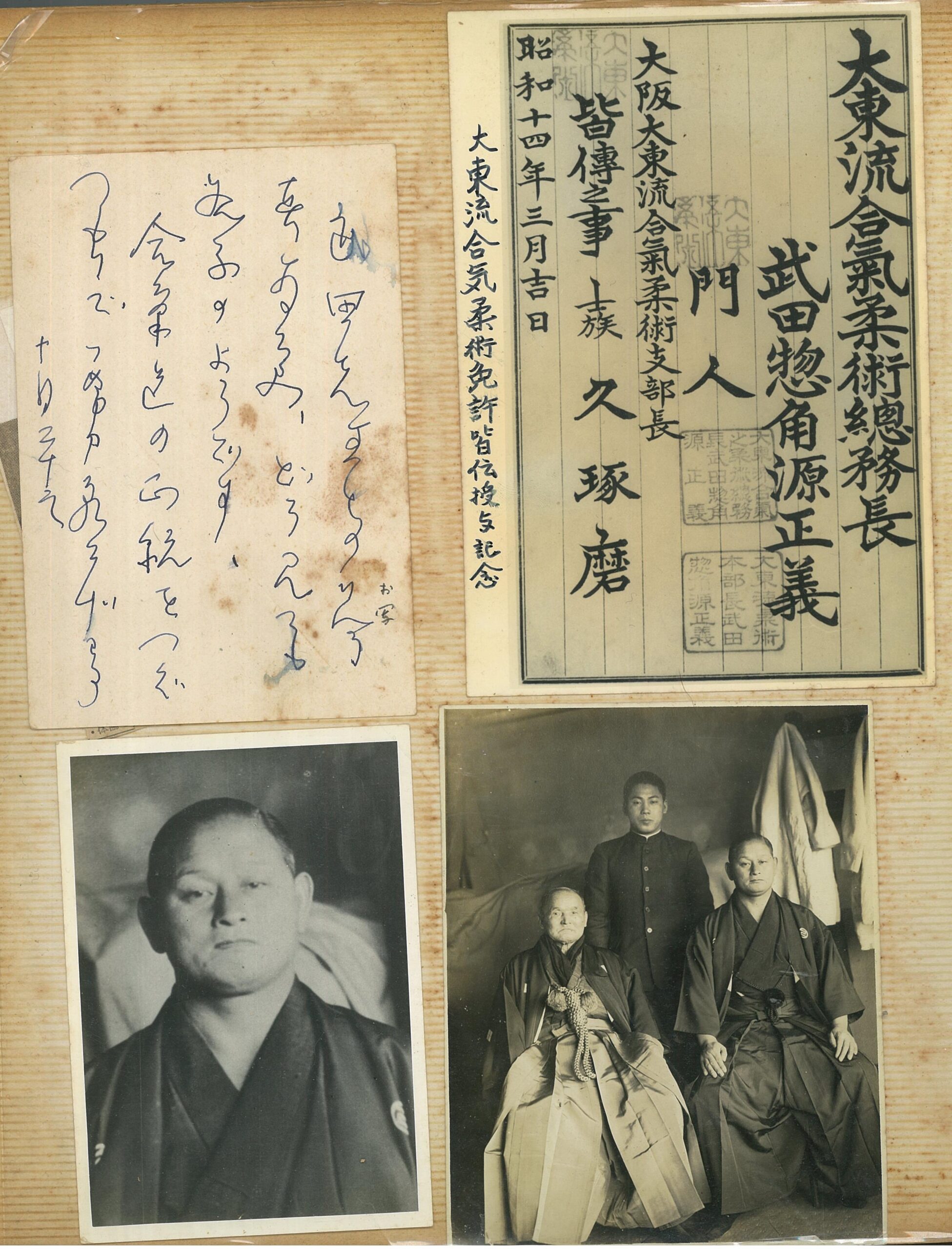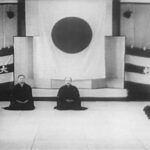Firstly, I was pondering what to write, but I’d like to start by writing the techniques practiced in TAKUMAKAI.
TAKUMAKAI preserves the techniques of Soden transmitted by Master Takeda Soukaku and Master Ueshiba Morihei and Shoden established by Master Takeda Tokimune, a son of Master Soukaku. While those who train Daitoryu are undoubtedly familiar with this, I hope to contribute to a deeper understanding of these backgrounds.
In chronological order, “Soden-waza” was transmitted to Hisa Takuma before World War II, and the “Shoden-waza” was organized and established after the war.
“Soden-waza” was compiled with explanations written alongside photographs of techniques taught by both two Masters to Hisa Takuma, the General Affairs Director of Asahi Newspaper headquarters of Osaka, and his team of subordinates in the Security Department. It consists of eleven volumes, including two volumes that were extracts and rearrangements from the original nine volumes. The techniques featured amount to 547, with volumes one to six instructed by Master Ueshiba Morihei, and volumes seven to nine by Master Takeda Sokaku. (It’s noted that there were many additional techniques not captured in photographs.)
“Shoden-waza” was established by Master Takeda Tokimune, the son of Takeda Sokaku.
To be more precise, he developed the “Daitoryu Jujutsu Hiden Mokuroku”which was passed down by Takeda Sokaku into the “Daitoryu Aikijujutsu Hiden Mokuroku”. Additionally, he systematically categorized the newly named 118 forms into five principal. (Hiden ; secret or classified, Mokuroku ; lists and orders of names)
This is also a well-known story, but strangely, there were no clearly named forms transmitted in Daitoryu until then. The former Somucho Mori Hakaru often said, this was something that troubled practitioners in old days. The systematic organization of Daitoryu forms and names was groundbreaking, and Master Tokimune’s significant contribution led to increased ease in training and a growth in the number of Daitoryu practitioners.
I heard that the establishment of the 118 forms had taken several years—whether it was five, eight, or even longer is uncertain. It’s just an estimate, but the duration might depend on whether we count from the beginning of the conception of the idea or the actual compilation. Of course, there likely was a process of repeated practice, validation, and refinement which make it quite a lengthy journey for Master Tokimune himself.
To provide a bit of context, it is said that Makita Kanichi Sensei in Tokushima visited Daito-kan at Abashiri in north-east of Hokkaido, where Master Tokimune resided, and Master Tokimune also came to Tokushima where Makita Sensei lived and taught. This was how Master Tokimune started to teach Shoden 118 techniques to his father’s old students’ descendants.
Makita Sensei was a student of Nakatsu Heizaburo, who used to be a member of Hisa’s Security Department and belonged to the class of Master Takeda Sokaku and Ueshiba Morihei in Asahi Newspaper headquarters. After Master Nakatsu past away, Makita Sensei joined Master Hisa’s disciples. Then began the substantial interaction with Makita Sensei and Master Tokimune around the year 1968. This is also when Hisa Takuma left Osaka for Tokyo, where his children lived, because Master Hisa was too old to live alone. This account is based on inaccuracies. So, please note that the details around this story are based on fragmentary accounts and old documents, so there might be inaccuracies. Any corrections will be made promptly, so please bear with me.
Many disciples of Nakatsu Dojo participated in the training sessions of Master Tokimune. Among them were notable figures such as Makita Sensei, Chiba Sensei, and Onishi Sensei. Additionally, other disciples I have had the privilege to meet, like Kimura Sensei and Izawa Sensei, were also part of the sessions.
Master Tokimune was also on friendly terms with Master Hisa. There is a well known commemorative photo which Hisa, Sokaku, and the young Tokimune took together when Hisa received his “Menkyo Kaiden”, full transmission of the license, In 1939.
That’s how the things used to be during those days. I’ve heard that Master Tokimune always dropped off in Kansai to teach Shoden techniques on his way whenever he visited Master Nakatsu’s disciples in Shikoku. (By the way, during this period, Takumakai did not exist yet, but Hisa Sensei’s disciples were practicing at the Kansai Aikido Club.)
Arriving a bit later, Okabayashi Ryoichi Sensei stayed in Abashiri for about a month, diligently practicing. Subsequently, he continued visiting Abashiri and kept training under Master Tokimune, dedicating himself so much that it was called as “Journeys of Devotion to Abashiri” During the same period, other future teachers, including young Kobayashi Kiyohiro Sensei and others who founded Takumakai later, also undertook training, visiting places like Hokkaido and Tokyo in pursuit of Sokaku’s lineage.
However, it was challenging to learn all 118 techniques of the Shoden directly from busy Master Tokimune. Instead, Suzuki Shinpachi Sensei, a senior disciple of Master Tokimune, provided detailed guidance. This was how the future members of Takumakai, disciples of Master Hisa, began to systematically learn the Shoden techniques under the leadership of Makita Sensei and Okabayashi Sensei.
In 1975, Takumakai was established. It is also a well-known story that Chiba Sensei of Wakimachi in Tokushima proposed this name. In photos from those days, we can see figures like Master Hisa, Makita Sensei, former Somucho Mori Hakaru, Amatsu Yutaka Sensei, Kobayashi Kiyohiro Sensei, Kawabe Takeshi Sensei, and other senseis together, indicating active exchanges between Kansai members and Shikoku members. Furthermore, at the 9th Japan Kobudo Embu Taikai(Japan Traditional Martial Arts Demonstration Event) held in Okayama in 1985, Mori Sensei and Makita Sensei performed Daitoryu demonstrations among many other groups of Japanese traditional martial arts.
There is still much I don’t know about historical matters. By researching and sharing information in this way, I believe that new insights and corrections to misunderstandings or errors in stories I’ve heard may come to light. Please be aware that there are possibilities of revising or adding to these essays in the future. The more detailed information on Soden and Shoden will be written in a future post.


